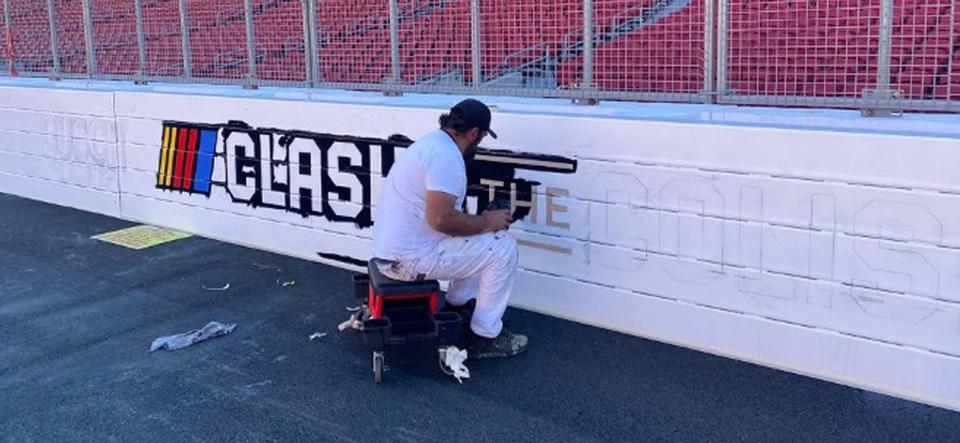Turf to tar: What it takes to prepare the LA Coliseum for the Busch Light Clash
Editor’s note: NASCAR Studios has partnered with students from the University of Southern California’s Annenberg School for Communication and Journalism to provide content for the Busch Light Clash. This story is by Jacqueline Cao, who is pursuing a Master of Arts in Public Relations and Advertising.
Since 1923, the Los Angeles Memorial Coliseum has functioned as an anchor for many of the city‘s sporting events and competitions, including the Olympic games, World Series and Super Bowl. The stadium is also home to the USC Trojans’ football team and its devoted fanbase. This year‘s NASCAR Cup Series Busch Light Clash marks NASCAR‘s second time constructing a quarter-mile racetrack inside the landmark facility.
When the NASCAR crews started their Coliseum build this past December, the final football game had been played less than a month prior and the playing field had been left untouched. This meant that NASCAR had only six weeks to transform the field into a temporary race track. Here is how NASCAR achieved this incredible feat in such a short amount of time:
First, bringing in the materials “[took] an army to move,” said Jeremy Casperson, director of civic engineering. The building process required 30 crew members, 9,200 cubic yards of material and 1,500 cubic yards of asphalt. It consisted of four major phases: delivering the materials, lifting and paving the field, setting the walls and painting the track.
Similar to a game of Tetris, space and timing were crucial.
RELATED: Full Clash weekend schedule | What to do in LA while visiting for the Clash
The engineering and building crews had to locate and transport materials that had been stored all over Southern California after last year‘s Clash: The walls were in Fontana and Long Beach, the asphalt was brought in from Irvine and the dirt was stored in Anaheim. The availability of bulk materials was also an important reason why NASCAR utilized such a widespread network across the region, he explained.
Due to the limited area in and around the Coliseum, his team also had to ensure that the deliveries were scheduled correctly to prevent overcrowding and further challenges.
With the newly arrived materials, the crew lifted the surface of the field four feet. Doing this, as well as laying down the dirt, was a process that took “the better part of two weeks,” Casperson said. When finished, the middle track was 18 inches higher than the original field level; the outside track was four feet higher.
After raising the surface, the crew paved it with 1,500 cubic yards of asphalt over a series of three days. At every race track, and even on roads, asphalt is used to help cool down the rubber of tires spinning at full speed. If you ever get a chance to walk on the race track, touch the ground and feel how cold the asphalt will be even if it‘s been baking in the LA sun.
After the track was completed, the contractors installed three outer walls around the oval: the front barrier, the steel barrier and the back barrier.

The most salient element of these walls was the SAFER barrier, shorthand for the Steel and Foam Energy Reduction barrier, which was comprised of large Styrofoam blocks. Inserted between the barriers, the SAFER wall helps protect the drivers and race cars — and even spectators — by absorbing and reducing kinetic energy upon impact. This layer was essential for the Coliseum because the track‘s short quarter-mile length led to a higher possibility of drivers bumping into and against the walls.
And after more than a month of building, setting and installing, finally, it was time for the finishing touches.
Professional painting crews arrived to hand paint logos on the walls and stripes on the track. Since the Clash is one of the last few competitions that still has hand-painted logos, they aptly mirror the rustic and vintage feel of the historic LA venue.
After the final checkered flag waves to declare a winner at the Clash, the construction crews will have only two weeks to deconstruct the walls, restore the playing field to its original level and return the materials back to their respective locations to await their next use. For Casperson, this is a swift process with which he is quite familiar.
But not too long after the Clash, he and his team will immediately proceed to an exciting and revolutionary new project: the Chicago Street Race.
To see the track in action and the culmination of the crews‘ hard work, don‘t miss the second-ever Busch Light Clash at The Coliseum, airing Feb. 5 at 8 p.m. ET on FOX, MRN and SiriusXM NASCAR Radio. Tickets are available here.

